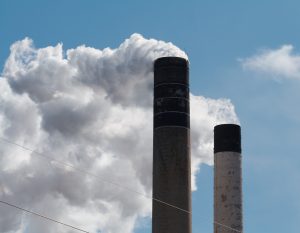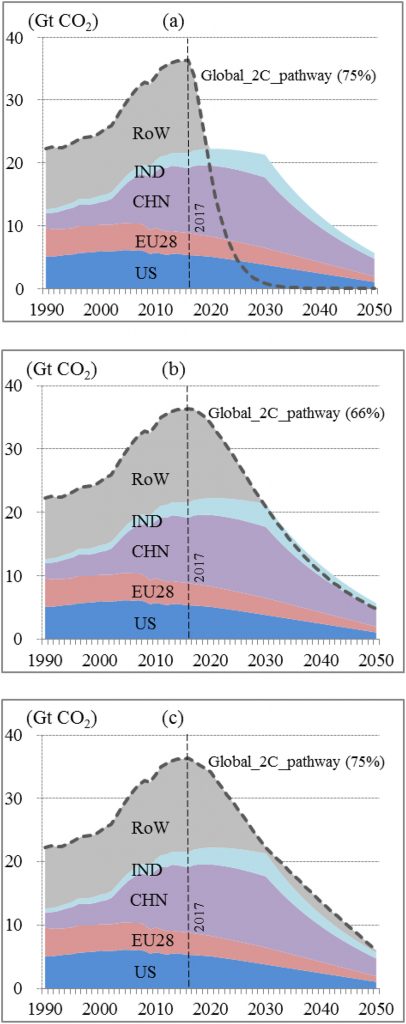23 April 2019
WASHINGTON— New research highlights the “incredible challenge” of reaching the Paris Agreement without intense action and details the extreme temperatures parts of the planet will suffer if countries fail to reduce emissions.
The world reached an agreement in December 2015 on curtailing greenhouse gas emissions with the goal of avoiding a 2-degree Celsius increase in average global temperature above pre-industrial levels. Ideally, the treaty’s goal is to limit this increase to 1.5 degrees Celsius. The United States delivered notice to the United Nations in August 2018 of the country’s intention to withdraw from the Paris Agreement, joining Syria as one of only two countries in the world not party to the treaty.
Two new studies published in the AGU journals Geophysical Research Letters and Earth’s Future now show some of the goals set forth in the agreement might be difficult to reach without much sacrifice.
The new research shows future climate extremes depend on the policy decisions made by major emitters, and that even if major emitters were to strengthen their commitments to reducing emissions, the rest of the world would have to immediately reduce their greenhouse gases to zero to achieve the Paris 2015 goal.
“Simply put, these papers highlight the incredible challenge the 2015 Paris Agreement presented to the world,” said Dáithí Stone, a climate scientist with the National Institute of Water and Atmospheric Research, a crown-owned research company in New Zealand, who was not involved in either of the studies.
Importance of major emitters

Smokestacks in Champaign, Illinois. Two new studies show future climate extremes depend on the policy decisions made by major emitters, and that even if major emitters were to strengthen their commitments to reducing emissions, the rest of the world would have to immediately reduce their greenhouse gases to zero to achieve the Paris 2015 goal.
Credit: Wikimedia Commons
The first study, published in AGU’s Geophysical Research Letters, found none of the world’s major carbon emitters, including the U.S., China and the European Union, have made commitments calculated to align with limiting climate warning to a 2-degree Celsius increase above pre-industrial levels.
If these major emitters fail to enact stronger policy changes curtailing their emissions more significantly, specific parts of the world like eastern North America and Central Europe will experience periods of extreme temperatures, according to the new study.
“What’s going on now matters, and it matters at the emitter level,” said Sophie Lewis, a senior lecturer at the University of New South Wales and the lead author of the new study.
She and her co-authors used models projecting future climate patterns in certain parts of the world to show how the failure of these high-emitting countries would directly lead to problems there.
In many regions of the world, future extreme temperature events depend on the current and future carbon dioxide emissions reductions adopted by major emitters, according the new research. For example, if the U.S. fails to limit the country’s emissions, it will lead directly to extreme temperatures in places like Central Europe and eastern North America.
Lewis said not all future impacts are clear, but the data is good enough for Central Europe and eastern North America to show how an average world temperature increase would directly impact those regions.
“In Central Europe it was really clear that there was so much to gain by limiting temperature increase to 1.5 or 2 degrees,” she said.
While Lewis said the onus will be on all countries in the future to limit the impact of climate change, the high-emitting regions of the world have an important role in leading reductions. By implementing stronger climate pledges, major emitters can reduce the frequency of future extremes and their own calculated contributions to these temperature extremes, the study’s authors noted.
Studies like this are important since they can be used in the future to hold large emitters accountable for failure to limit the effects of climate change, according to the study’s authors.
“Extending standard methods of evaluating the increased risk of extreme events due to climate change, they quantify the contribution of individual large carbon dioxide emitter nations to future risk increases,” said Michael Wehner, a senior staff scientist at the Lawrence Berkeley National Laboratory managed by the University of California, who was not involved in either of the recent studies.
“As the authors point out, this provides one method to assign liability for loss and damages during extreme weather events,” Wehner said.
The tough future for developing countries
In a second study, published in Earth’s Future, researchers found the come-one-come-all approach to global climate mitigation set forth in the Paris Agreement masks a huge challenge faced by developing countries.
Even if U.S., China, the European Union and India increased their contributions to limit emissions, the rest of the world would need to drop to virtually zero emissions by 2030 in order for the planet to reach its goal of limiting the increase in temperature from pre-industrial times to 1.5 degrees Celsius, according to the new study.
The authors of the recent study said it would not be technically, politically or socially feasible for many of the world’s countries to reach this goal.
“It’s very easy to talk about the global average. But as soon as you peel back one layer of the onion, on the country level, these rules don’t apply anymore,” said Glen Peters, research director for the Center for International Climate Research (CICERO) in Norway and a co-author of the second study.
He said high-emitting countries have already done much of the damage when it comes to emissions, while the rest of the world is now expected to limit their industrial growth and development to reach global emissions goals.
“The pie is so small you’re basically going to starve developing countries unless there is a huge increase (in emission reductions) from countries like the U.S.,” he said.
According to Wehner the “inequity of global warming between the developed and developing nations” is revealed by both new studies.
“Undoubtedly, in the absence of new energy technologies, there would be significant negative implications for the modernization of developing nations and the alleviation of poverty if they were required to reduce emissions as outlined by [Peters’ paper],” he said.

These figures show the pathways at country level needed to make the Paris Agreement goal a reality. The figures show the carbon dioxide trajectories of emissions of the United States, European Union, China, India, and the Rest of the World from fossil fuels and industrial processes for the following scenarios: (a) Global warming under 2 °C with a 75% probability, with negligible development of engineered sinks and land use change (LUC); (b) global warming under 2 °C with a 66% probability and negligible development in engineered sinks and LUC; and (c) global warming under 2 °C with a 75% probability, and with scalable development in engineered sinks and LUC.
Credit: Jiang et al/AGU
A way forward
Peters, the co-author of the paper in Earth’s Future, said while his findings are grim, the world should not give up on reaching emissions targets. He said historically high-emitting countries like the U.S. and parts of Europe should commit to more reductions than the developing world to make up for past emissions.
Peters and his co-authors argue that in order to meet the goals of the Paris Agreement, leading countries need to develop low‐, zero‐ or even negative‐carbon‐emissions energy technologies that can be deployed at scale in the developing world.
Stone, with the National Institute of Water and Atmospheric Research, said Peters’ study shows no one country can slip up in the goal to meet climate goals.
“It is hard to argue against their conclusion that we need to start seriously considering options such as the deployment of solar geoengineering, with all of the risks that entails, if the world is serious about achieving the Paris Agreement goals,” he said.
###
Founded in 1919, AGU is a not-for-profit scientific society dedicated to advancing Earth and space science for the benefit of humanity. We support 60,000 members, who reside in 135 countries, as well as our broader community, through high-quality scholarly publications, dynamic meetings, our dedication to science policy and science communications, and our commitment to building a diverse and inclusive workforce, as well as many other innovative programs. AGU is home to the award-winning news publication Eos, the Thriving Earth Exchange, where scientists and community leaders work together to tackle local issues, and a headquarters building that represents Washington, D.C.’s first net zero energy commercial renovation. We are celebrating our Centennial in 2019. #AGU100
*****
Notes for Journalists
This paper is freely available. Journalists and public information officers (PIOs) can download PDF copies of the articles by clicking on these links:
https://agupubs.onlinelibrary.wiley.com/doi/10.1029/2018GL081608
https://agupubs.onlinelibrary.wiley.com/doi/10.1029/2018EF001078
Journalists and PIOs may also request a copy of the final paper by emailing Nanci Bompey at [email protected]. Please provide your name, the name of your publication, and your phone number.
Neither these papers nor this press release is under embargo.
Paper Title
“Assessing Contributions of Major Emitters’ Paris‐Era Decisions to Future Temperature Extremes”
Authors
Sophie C. Lewis: School of Science, University of New South Wales, Canberra, Australian Capital Territory, Australia;
Sarah E. Perkins‐Kirkpatrick: Climate Change Research Centre, University of New South Wales, UNSW, Sydney, New South Wales, Australia;
Glenn Althor: School of Earth and Environmental Sciences, University of Queensland, St Lucia, Queensland, Australia;
Andrew D. King: School of Earth Sciences, The University of Melbourne, Parkville, Victoria, Australia;
Luke Kemp: Centre for the Study of Existential Risk (CSER), University of Cambridge, Cambridge, UK;
Paper Title
“Global Rules Mask the Mitigation Challenge Facing Developing Countries”
Authors
Xuemei Jiang: School of Economics, Capital University of Economics and Business, Beijing, China;
Glen P. Peters: CICERO Center for International Climate Research, Oslo, Norway;
Christopher Green: Department of Economics, McGill University, Montreal, Canada.
Contact information for the authors
Glen Peters, CICERO Center for International Climate Research, Oslo, Norway;
+47-92-89-16-38
[email protected]
Chris Green, McGill University, Montreal, Canada;
+1-514-398-3837
[email protected]
Sophie Lewis, University of New South Wales, Canberra, Australia;
+61-2-6268-8890
[email protected]
Luke Kemp, University of Cambridge, Cambridge, UK;
+44-7477-898411
[email protected]
Andrew King, University of Melbourne, Victoria, Australia;
+61 383 447 997 (office), +61 424 803 867 (mobile)
[email protected]
Nanci Bompey
+1-202-777-7524
[email protected]